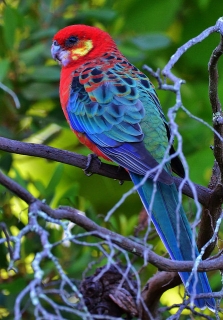Western Rosella |
|
|
Also known as: Stanley Rosella or Parakeet, Yellow-cheeked Rosella or Parakeet, Earl of Derby's Parakeet, Red-backed Rosella or Red-backed Stanley Rosella (P. i. xanthogenys)
Photos
View in GalleryDid You Know?
The Western Rosella is the only rosella to have yellow cheeks. The other species of this group have either white or blue cheeks.Academic Research
Related publications: Platycercus icterotisSpecies Profile
Genus: Platycercus | Species: icterotis
Size:
26cm (10 in)
Weight:
45-80g (1.6-2.8 oz)
Subspecies including nominate:
two: P. i. icterotis, P. i. xanthogenys
Colour Adult:
P.i. icterotis: Male-in general bright red; cheek patches yellow; black back, with green mottling occasionally mixed with red; green rump; dark green tail tipped with blue. Bill white. Eye dark brown. Female-dull red forecrown; green crown and sides of neck; yellow cheeks; green underparts washed with dull red; pale underwing stripe.
P.i. xanthogenys: Male-as in icterotis, but with grey/olive rump and upper tail coverts; red and greyish mottled back; cheek patches paler and cream/yellow; dark blue tail. Female-paler than icterotis, grey/olive rump and upper tail coverts; dark blue tail.
Colour Juvenile:
P.i. icterotis: Green head with orange/red frontal band; pale green breast, in males faintly washed with red/orange; pale underwing stripe.
P.i. xanthogenys: Duller than adult female.
Call:
Calls are described as soft and melodious. Are much quieter than other rosellas.
Listen NowVideo Links:
Video 1More Information:
Content Sources:
CITES
BirdLife International
Cornell Lab of Ornithology/Birds of the World
Parrots: A Guide to Parrots of the World, Juniper and Parr, 1998
xeno-canto Western Rosella, Graff, John XC178540
S. Milpacher, pers. comm., 2006
Parrots of the World, Forshaw and Cooper, 1977. 2010 edition
Parrots of the World, Forshaw, 2006.
Lexicon of Parrots, Thomas Arndt.
Parrots in Aviculture, Low, 1992.
Photos
View in GalleryDid You Know?
The Western Rosella is the only rosella to have yellow cheeks. The other species of this group have either white or blue cheeks.Academic Research
Related publications: Platycercus icterotisSpecies Care
Captive Status:
Common
Longevity:
25-40 yrs
Housing:
Walk-in enclosure, minimum length 3m (9.8 ft).
Diet:
Small seed mix such as: canary, millet and smaller amounts of oats, buckwheat, safflower and a little hemp; limited sunflower seed; spray millet; green leaves such as: Swiss chard, lettuce, dandelion, sowthistle, chickweed; seeding grasses; rearing food made from hard-boiled egg, wholegrains and carrot, all ground to crumbly consistency; fruits such as: apple, orange, banana, pomegranate; cactus fruits; complete pellet.
Enrichment:
Hearty chewer; provide unsprayed, flowering fruit tree branches, willow, fir, elder and pine branches. Also provide water bowls for bathing, and space to fly for exercise.
Nest Box Size:
Nest log or vertical box 9" x 9" x 24" (22.8cm x 2.8cm x 61cm).
Clutch Size:
5-8
Incubation Time:
19 days
Fledging Age:
5 weeks
Hatch Weight:
Not recorded.
Peak Weight:
Not recorded.
Weaning Weight:
Not recorded.
Specialist Club:
Photos
View in GalleryDid You Know?
The Western Rosella is the only rosella to have yellow cheeks. The other species of this group have either white or blue cheeks.Academic Research
Related publications: Platycercus icterotisSpecies Wild Status
World Population:
Unknown, decreasing.
IUCN Red List Status:
Least Concern
CITES Listing:
Appendix II
Threat Summary:
Not globally threatened. Xanthogenys near-threatened. This species probably benefits from some land clearance, but inland has been affected by massive, large scale deforestation and natural competition from Australian Ringneck (Barnardius zonarius).
Range:
P.i. icterotis: Coastal and subcoastal SW Western Australia.
P.i. xanthogenys: Interior of SW Western Australia.
Habitat:
Found in open and partly cleared Eucalypt woodland and forest, riverine forest, farmland, orchards, towns, clearings, roadsides, gardens, cultivated areas, pastures, wooded savanna and shrubland.
Wild Diet:
Diet includes seeds of grasses and herbs, with birds visiting stubble fields to pick up grain; also fruits, berries, nectar, buds, flowers of Eucalyptus marginata, coating of zamia palm Macrozamia reidlei seeds and ripening apples.
Ecology and Behaviour:
Generally seen in pairs or small groups which are quiet and fairly tame. Forms larger flocks where food is abundant. Nests in tree-hollow.
Clutch and Egg Size:
5-8 rounded eggs, 26.0 x 21.5mm (1 x 0.8 in).
Breeding Season:
August-December; nest is in tree or limb cavity.
Photos
View in GalleryDid You Know?
The Western Rosella is the only rosella to have yellow cheeks. The other species of this group have either white or blue cheeks.Academic Research
Related publications: Platycercus icterotisMembers Only Resources
Please log-in now to find more research, resources and tools.
Not a Member?
Find more great information:
Gain exclusive access to 600+ pages of additional research, seminars and podcasts, specialists to ask your toughest questions, and dozens of other fun resources - when you become a WPT member.
Join Today >>

































